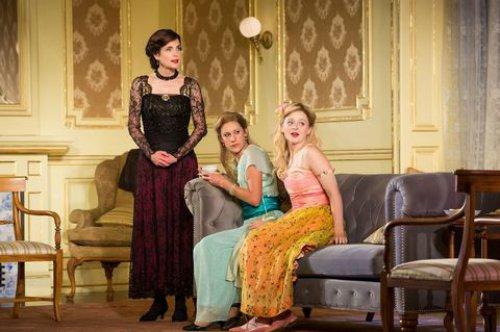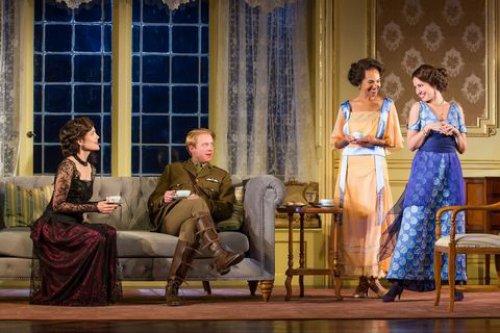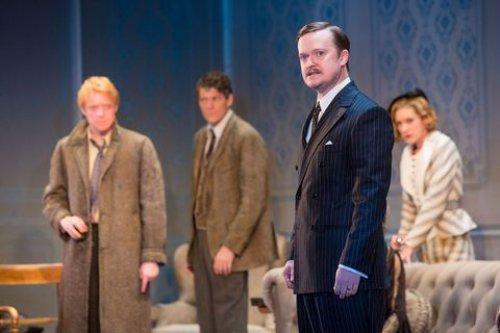Time and the Conways
Elizabeth McGovern returns to Broadway after 25 years in Priestley play about a wealthy British family that lives in the country and falls on hard times.

Elizabeth McGovern, Charlotte Parry and Anna Baryshnikov in a scene from J.B.Priestley’s “Time and the Conways” (Photo credit: Jeremy Daniel)
[avatar user=”David Kaufman” size=”96″ align=”left”] David Kaufman, Critic[/avatar]Much to New York’s benefit, director Rebecca Taichman’s recent 2014 revival of J. B. Priestley’s Time and the Conways for The Old Globe, San Diego, is now on Broadway, thanks to The Roundabout Theatre. It may have just as well been inspired by the enormous success of the long-running PBS series, Downton Abbey. Both the play and the series concern a wealthy, British family that lives in the country and falls on hard times, financially. They both also are set in the early part of the 20th Century, and then somewhat later. To add that they both also star Elizabeth McGovern as the matriarch of their respective households would seem to confirm the suspicion. The play brings McGovern back to Broadway for the first time in 25 years where she last appeared in the Roundabout’s production of Hamlet.
But they’re not about the same family. The large Conway brood of the play that bears their name consists of four daughters, two sons, and their mother–the father having died in a drowning accident before the play begins. Set in 1919, the first of three acts also occurs on Kay’s (Charlotte Parry) 21st birthday, when various guests are helping the Conways celebrate with a game of charades–among other things. Robin (Matthew James Thomas), one of the sons, is freshly back from the First World War, still dressed in his uniform and something of a hero. But by the second act, set in 1937 (which is when the play had its London premiere), Robin has become an alcoholic wastrel who nevertheless appears to be Mrs. Conway’s favorite child.
While the charades of the first act happen off-stage, we get to know more about each of the Conways. Kay is a would-be novelist. Her sister Hazel (Anna Camp) is more outgoing. And there’s the politically minded, no-nonsense Madge, who seems to belong to a different world, given her convictions. (She’s brought to life with a certain pert, in-control performance by Brooke Bloom.) But keep your eyes on Carol (Anna Baryshnikov), who is going to die between the first and the second acts, but remains on stage throughout.
Though we didn’t foresee it coming, most of the characters have married by the second act. The Conways are, in 1937, hoping one of the husbands will bail them out. Though, in a very dramatic outburst, he refuses to, his reasons become clearer during Act III, which returns us to Kay’s birthday party in 1919, essentially picking up where it left off at the beginning of the second act.

Elizabeth McGovern, Matthew James Thomas, Cara Ricketts and Anna Camp in a scene from J.B. Priestley’s “Time and the Conways” (Photo credit: Jeremy Daniel)
Though the first two acts are played as one during the current, Roundabout production, there’s no mistaking Priestley’s message between them. More than a message, it becomes the crux of the play, really: the now deceased Carol is there, observing all that her siblings and friends are doing in the future. Is it that Carol is looking back from the hereafter or that she foresaw the future?
Such a time-inquiry is typical of Priestley (consider his most famous play, An Inspector Calls), who astonishes as he keeps us guessing what’s going on. Though Time and the Conways is, on a basic level, just another soap opera about a family with financial woes (August, Osage County, anyone?), Priestley introduces philosophical questions worthy of William Blake, who is cited in the play, and of Virginia Woolf, who is hinted at in an odd moment, when Carol projects living in London with her sister and one of their brothers, which was exactly what Virginia Woolf and her sister Vanessa Bell did, when they lived with their brother Thoby. The past may always be the past, but its roots are always in the present, just as they are in the future. This notion of a continuous present was something that Virginia Woolf, no less than William Blake, dwelled on in their work. And it was apparently a major inspiration for Priestley in this play.
As Alan says to Kay at the end of Act II, “Time’s only a kind of dream…. It merely moves us on–in this life–from one peephole to the next.” When Kay responds, “But the happy young Conways, who used to play charades here, they’ve gone, for ever,” Alan replies: “No, they’re real and existing just as we two, here now, are real and existing. We’re seeing another bit of the view–a bad bit, if you like–but the whole landscape’s still there.”
The decision to have Carol remain on stage for the second act was evidently made by director Taichman, since it doesn’t appear in the script, and it perfectly illustrates Priestley’s complicated theme. It’s also brilliantly achieved by having the stage slide back, before a new set descends from above and replaces it, the rear-wall now a thin mesh through which we can see the old setting–or the same parlor of the Conways’ home, with Carol in silhouette, in Christopher Akerlind’s subtle lighting. The newer set is, of course, faded and a shadow of its former self–as are the Conways. Set designer Neil Patel is a great asset in realizing the effect. And the period costumes by Paloma Young are also on target.

Matthew James Thomas, Gabriel Ebert, Steven Boyer and Charlotte Parry in a scene from J.B. Priestley’s “Time and the Conways” (Photo credit: Jeremy Daniel)
And then there are the actors, who are uniformly effective, which testifies to director Taichman’s control of the material. Though it would be time-consuming and difficult to delineate each of the many performers, I list them here with applause for their efforts: Elizabeth McGovern, Steven Boyer, Anna Camp, Gabriel Ebert, Charlotte Parry, Matthew James Thomas, Anna Baryshnikov, Brooke Bloom, Alfredo Narcisco and Cara Ricketts.
Thanks to Taichman’s overseeing of the production, Time and the Conways is most successful as both an old-fashioned play and as a philosophical investigation of life and time, as the title suggests. It’s about living in the present, which is where we should all aspire to be but rarely are, thinking of or living in the past and the future instead. Priestley’s genius was for putting his story in all time frames simultaneously, as it were.
Time and the Conways is the kind of play that you’ll want to see if you want to contemplate life and its many complexities. It gets you wondering about where you’ve been and where you’re going to be. And who can ask for anything more?
Time and the Conways (through November 26, 2017)
Roundabout Theatre Company
American Airlines Theatre, 227 West 42nd Street, in Manhattan
For tickets, 212-719-1300 or visit http://www.roundabouttheatre.org
Running time: two hours and 20 minutes including one an intermission






Leave a comment